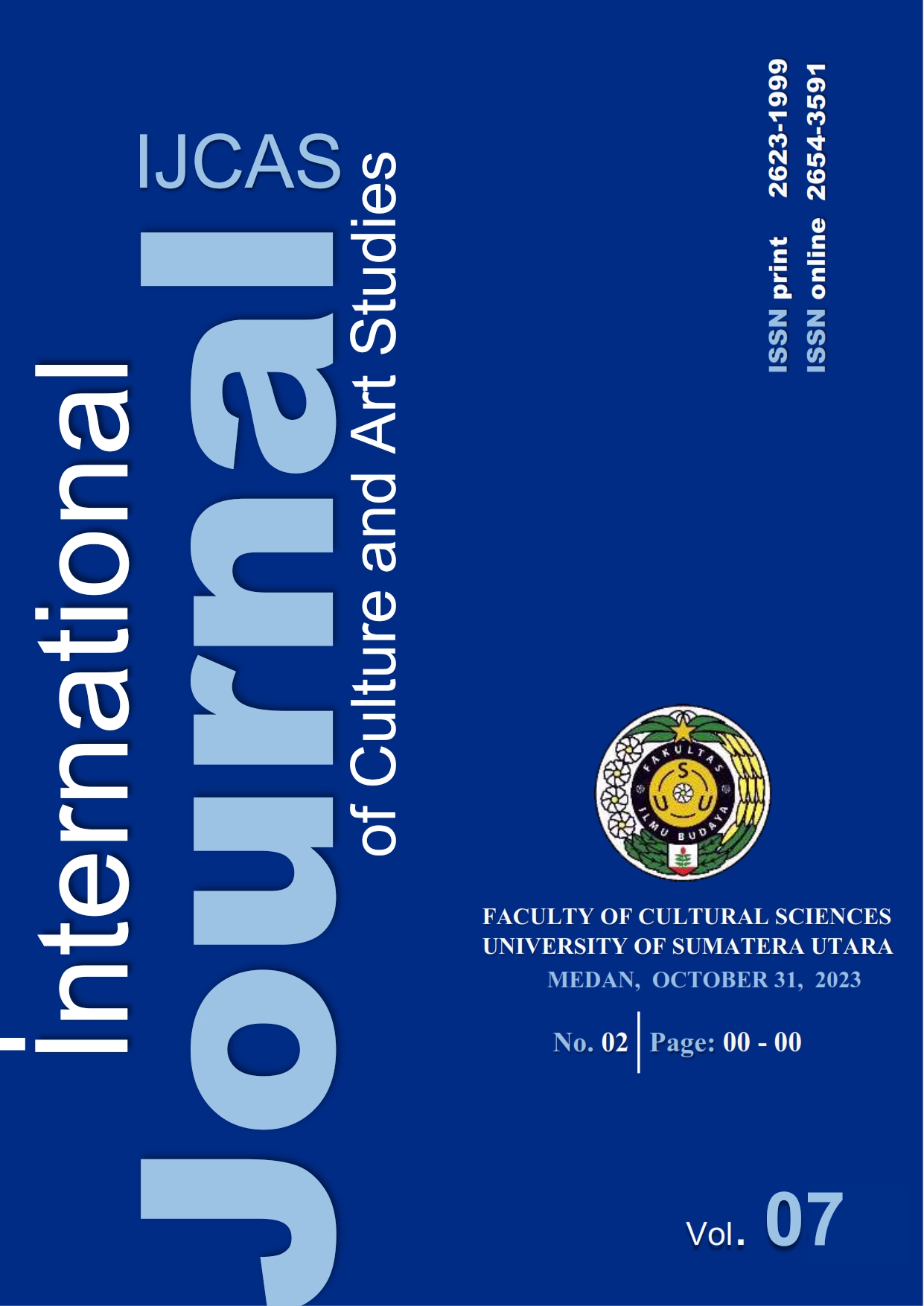Semiotics of Factory Printed Wax Prints across West Africa
DOI:
https://doi.org/10.32734/ijcas.v7i2.12684Keywords:
Design, Semiotics, Visual Representation, Wax print, West AfricaAbstract
This research explores the topic of factory-printed wax fabrics in West Africa, focusing on their portrayal and significance within the region. The study examines the resemblances and distinctions of these prints across different countries, as well as their applications, meanings, and interpretations. The historical and cultural importance of wax prints in West African society, culture, and economy is emphasized, highlighting the diverse meanings embedded within seemingly uniform designs. The research methodology involves qualitative research and selective sampling, with ten wax print designs chosen for analysis in Ghana, Nigeria, Cote d'Ivoire, and Togo. These countries were selected based on their integration, trade, production, and cultural significance related to wax prints. Data collection involved meticulous observation, thorough documentation, interviews, and thematic analysis. The findings reveal both similarities and differences among the analyzed designs, each representing unique narratives and embodying cultural significance. These prints are not just patterns, but also vessels of history, with captivating stories intertwined with their origins. To ensure the preservation and relevance of these visual representations for future generations, it is recommended to undertake comprehensive documentation and cataloging of traditional wax prints.
Downloads
References
Acquaye, R. (2018). Exploring indigenous West African fabric design in the context of contemporary global
commercial production, PhD dissertation, Winchester School of Art., University of Southampton.
Acquaye, R., Sawyerr, N. O., Kusi. (2022). West Africa Prints: fusion of global textile design traditions in
Textiles and clothing along the silk roads, p. 243-255, 2022.
Burke, S. (1983). Dye and Printed Textiles: Dutch Wax Prints. Ethnographic Resources for Art Education.
Department of Arts, Birmingham Polytechnic.
Clarke, D. (1977). The Art of African Textiles. San Diego: Thunder Bay Press.
Each fabric has a story, Common threads: Afro-Asian textile. Retrieved at
https://oliveankara.com/pages/fabrics-stories-oliveankara (3Oth July, 2022)
Fabric stories. Retrieved at https://www.vlisco.com/world-of-vlisco/design/fabric-stories/ (14th October,
.
Fashionomics Africa. The fashion and Textile Industry: A promising sector for Cote d’Ivoire?. Retrieved at
https://fashionomicsafrica.org. (17th August, 2022).
Howard, K. & Osei-Ntiri, K. (2013). African Prints in Retrospect: A Case for Future Textile Design
Development. Journal of Art Design and Technology, 1 (4), p14 - 23
Howard, E.K., Sarpong, G.D. & Amankwah, A.M. (2012). Symbolic Significance Of African Prints: A Dying
Phenomenon In Contemporary Print Designs In Ghana. International Journal of Innovation Research
and Development, 1 (11), p609 - 624.
Impraim-Swanzy, E., Oduro, B. A. & Owusu, O. C. (2019). Cultural and Symbolic Interpretation of Selected
Wax Print Designs on Ghanaian Fabrics. International Journal of Educational Research, 3 (5), p1 - 16.
Labode, O.J. & Braide, O.O. (2022). Symbolic Designs of Textile Art in African Fabrics. The Polish Journal
of the Arts and Culture, 2 (16), p 71–86.
Map of Africa highlighting West Africa. Retrieved at
https://upload.wikimedia.org/wikipedia/commons/1/15/Africa-countries-WAFU-UFOA.png (20th
August, 2022).
Moulin, T., The Ghanaian Textile, an industry at risk . Retrieved at www.echosdughana.com. (17th August,
.
Nielsen, T. R. (1974). The History and Development of Wax-printed Textiles Intended for West Africa and
Zaire, Masters dissertation, Department of Human Environment and Design., Michigan State University.
Nielsen, R. (1979). The History and Development of Wax-Printed Textiles Intended for West Africa and Zaire
in The fabrics of culture: The Anthropology of Clothing and Adornment; p. 467-498.
Relph, M. & Irwin, R., (2010). African Wax Print: A Textile Journey. United Kingdom: Words and Pixels.
Vodochodsky,J.,Wandering Spirit, African Wax Prints. Retrieved at
https://www.blogger.com/profile/04565017129651117853, (11th July, 2022).
West African map showing the countries with their colonial names. Retrieved at https://folukeafrica.com/a-
short-history-of-west-africa/ (20th August, 2022).
Wolgemuth JR, Agosto A. (2019). Narrative Research. New York: John Wiley & Sons Ltd.
Downloads
Published
How to Cite
Issue
Section
License
Copyright (c) 2023 Naa Omai Sawyerr, Richard Acquaye, Cynthia Agyeiwaa Kusi

This work is licensed under a Creative Commons Attribution-ShareAlike 4.0 International License.













